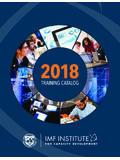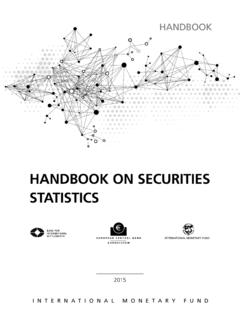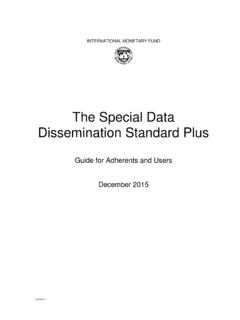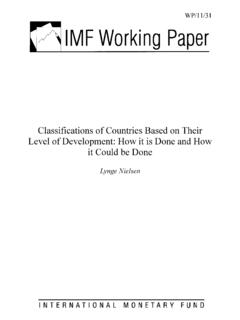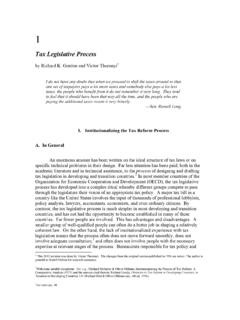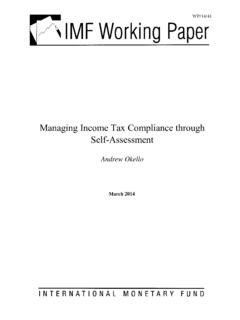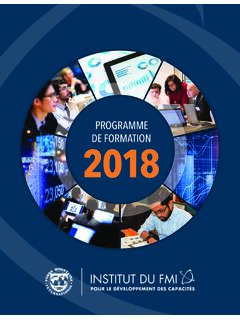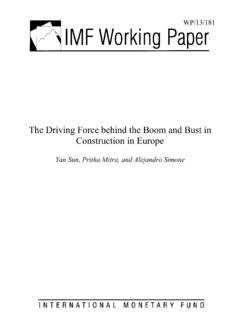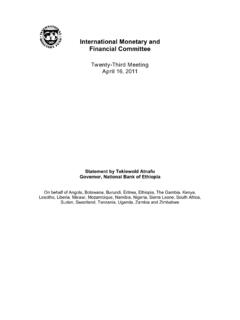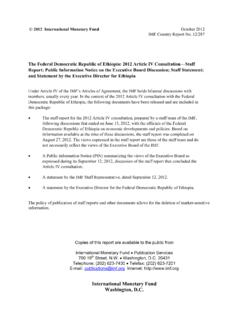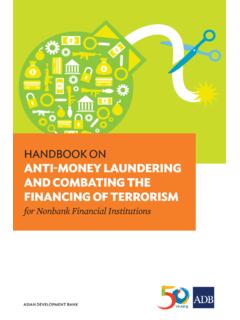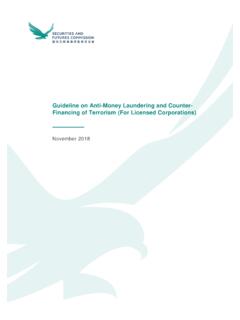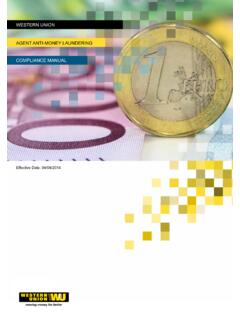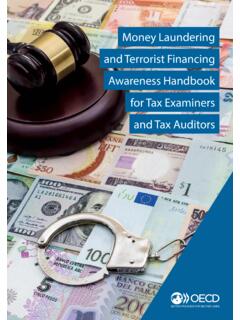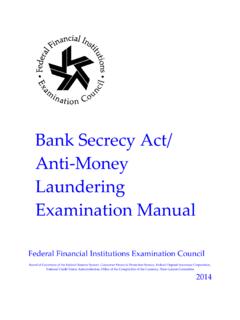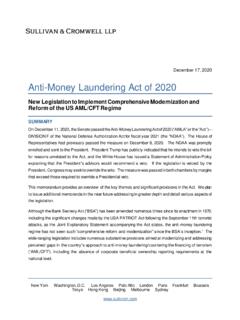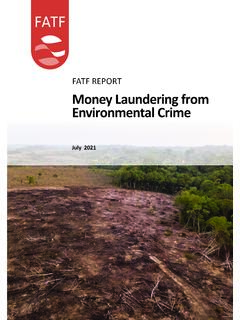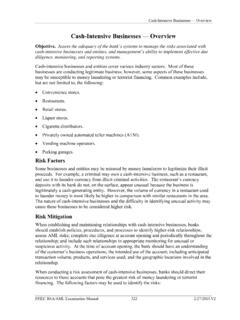Transcription of MONEY LAUNDERING AND TERRORISM FINANCING: AN …
1 MONEY LAUNDERING AND TERRORISM financing : an overview Jean-Fran ois Thony1 The purpose of this overview is to examine why and how criminal and terrorists organizations use legitimate financial institutions to move and store assets, and how lawmakers have built on that fact to propose innovative and more efficient responses to crime problems. Profits generated by some organized criminal activities, such as drug trafficking or traffic in human beings, cause a threat not only to public safety, because of the huge economic power accumulated by a number of criminal organizations, but also financial systems themselves and to economic development. Recent events showed that terrorist groups also build financial empires, the purpose of which are specifically to undermine public safety and international financial stability.
2 The international efforts to combat MONEY LAUNDERING since the beginning of the 1990s are built on strategies aiming at attacking criminal organizations through their financial operations, firstly to deprive them of the means to act, and secondly, by unraveling the web of their financial networks and financing methods; to gain knowledge of how better to combat them. This strategy was first developed in the late 1980s, when law enforcement was faced with the growing threat caused by the Colombian drug cartels, particularly the Cali and Medellin cartels. Both criminal organizations accumulated such wealth and power that the issue turned from a public safety problem to a threat against the State itself.
3 The anti- MONEY - LAUNDERING strategy developed at that time was in response to the reality that the traditional means for combating organized crime had reached the limits. The only existing weakness of criminal organizations was their need to utilize the legal channels of the banking and financial system to transfer funds and disguise the origin of assets. The necessity to put these funds on the market made them extremely vulnerable, and tracing the LAUNDERING process was a more cost-effective and a less dangerous means to achieve law enforcement objectives. Such a strategy had also the advantage of targeting efforts on the richest and thus most dangerous criminal organizations. The tragic events of September 11 showed that the rationale of this strategy could be applied mutatis mutandis to terrorist groups.
4 It also demonstrated that all the efforts to improve financial transparency in order to better track criminal MONEY had achieved a 1 Mr. Thony originally delivered this paper on May 10, 2000 during which time he served as a Judge with the Court of Appeals, Versailles, France. Mr. Thony has since joined the IMF Legal Department as Assistant General Counsel, and has included a number of updates to this version of the paper. -2-limited result. In many cases, criminal investigators were still unable to trace movements of suspect funds and to identify, behind shell companies or offshore bank facades, the real ownership of suspicious assets. -3-I. MONEY LAUNDERING and financing of TERRORISM : Fundamentals Criminal organizations are involved primarily in profit-making crime.
5 They are constituted for this purpose as well as to exploit crime opportunities in a systematic and large scale manner. The consequence is that the operation of a criminal organization may generate a vast amount of wealth, but at the same time, a vast number of problems. The generated cash is neither easy to hide nor to utilize. Sudden use of unexplained wealth may raise suspicion. Investigators may easily establish a link between cash, illicit activities, and their perpetrator. It is thus necessary, for criminal organizations to, (1) erase the link between the crime and the MONEY , (2) erase the link between the MONEY and its new owner, and finally (3) shelter the profits from possible confiscation. The above activities constitute the very nature of MONEY - LAUNDERING , which generally develops in three phases: - The first phase consists of introducing the funds gained from criminal activities into the banking and financial system; this phase has become more and more fraught with risk due to the heightened attention now given these movements of cash by law enforcement, and the now widespread requirement that banks report suspicious transactions.
6 - The second phase consists of putting the funds that have entered the financial system through a series of financial operations, the purpose of which is to mislead potential investigators and to give these funds the appearance of having a legal origin. This is the MONEY - LAUNDERING phase that most often uses offshore mechanisms. Numerous comings and goings between financial havens and the launderers banks, punctuated by false invoices, false loans, or other devices, ultimately mislead investigators regarding the origin of the MONEY . - Finally, the third phase in MONEY - LAUNDERING , once these funds appear to have a legitimate origin, consists of reintroducing the funds into the legal economy, - through consumption of luxury items, since the goal of profitable criminal activity is first to be able to burn the ill-gotten funds; - through investments in common place assets, including shares in companies, real estate, etc.
7 ; - through investments in economic entities that are themselves susceptible of becoming MONEY LAUNDERING machines including casinos, hotels, restaurants, cinemas, etc., as well as in companies in which payments are made in cash and where the dirty MONEY can easily be mingled. The above description of MONEY - LAUNDERING mechanisms takes a simplified view of the process. The reality may be more complex or more basic depending on certain factors that -4-impact the MONEY LAUNDERING strategies of criminal organizations, such as the quantity of assets, the structure and level of organization of the criminal organization, and in particular, the hiring of financial experts to develop and implement MONEY LAUNDERING schemes.
8 If experts agree on the fact that the magnitude of what could be called the Gross Criminal Product could be as high as 1,000-1,500 billion dollars every year, the amount of criminal funds laundered is much lower. Some authors even argue that criminal organizations tend not to engage in MONEY LAUNDERING practices because of the related costs (Kopp, 2000). It is clear that only those criminals that accumulate more wealth than they can actually spend will engage in MONEY LAUNDERING practices, and these assets are a small portion of the total of proceeds of crime, probably not more than 10 to 30%. The Strange Links Between Organized Crime and TERRORISM MONEY LAUNDERING and the financing of TERRORISM may be seen as distinct activities.
9 The LAUNDERING of criminal funds aims at giving a legal appearance to dirty MONEY , whereas the LAUNDERING of terrorist funds aims at obscuring assets of a legal origin (such as public funding or so-called charities). This distinction is useless, however, since the objective of public policies is not to address the issue of the processing of illegal funds, but the funds themselves and the organizations behind them. In this regard, criminal assets and terrorist assets represent the same threats to financial systems and public institutions, and it is clear that the strategies designed to fight criminals when they channel their funds through financial systems may apply with the same success in combating terrorist financing cases.
10 In addition, mysterious ties often unite organized crime and TERRORISM . A sort of objective alliance forms in many instances between criminal and terrorists groups, fed by their convergent interests: criminal organizations benefit from the ability of terrorist and guerrilla organizations to do damage, while the latter in turn benefit from the financing that criminal activities can obtain for them. The strange similarity between the geography of TERRORISM movements and other guerrillas and the geography of large-scale drug trafficking is self-explanatory: the Revolutionary Armed Forces of Colombia (FARC) are to be found in coca producing areas, whilst the African civil wars are taking place in areas where precious stones and other natural riches are extracted; the soldiers of Al-Qaeda in Afghanistan and the Khun Sa rebels in Myanmar foment their armed actions in the world s largest opium-producing areas.
